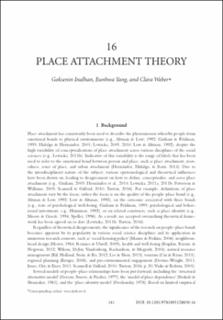Please use this identifier to cite or link to this item:
https://doi.org/10.21256/zhaw-22727| Publication type: | Book part |
| Type of review: | Editorial review |
| Title: | Place attachment theory |
| Authors: | Inalhan, Goksenin Yang, Eunhwa Weber, Clara |
| et. al: | No |
| DOI: | 10.1201/9781003128830-16 10.21256/zhaw-22727 |
| Published in: | A Handbook of Theories on Designing Alignment between People and the Office Environment |
| Editors of the parent work: | Appel-Meulenbroek, Rianne Danivska, Vitalija |
| Page(s): | 181 |
| Pages to: | 194 |
| Issue Date: | 2021 |
| Publisher / Ed. Institution: | Routledge |
| Publisher / Ed. Institution: | London |
| Language: | English |
| Subject (DDC): | 155: Differential and developmental psychology 331: Labor economics |
| Abstract: | This chapter explores current thinking about place attachment in the workplace. Place attachment describes the emotional bond between person and place. In the field of environmental psychology, place attachment has been identified as a significant predictor of an individual’s decision to act in a physical environment. However, the construct of place attachment has received scant attention in extant management literature. However, organisations are often forced to modify their places of work and relocate employees in response to new business strategies. The impact of these changes on people and work are rarely considered. People exhibit varied responses to such changes, with drastic changes requiring careful adjustments to address ‘emotional’ transitions. Can place attachment provide a useful concept for guiding workplace decisions? This chapter seeks to expose the gaps in our understanding of ‘attachment’ as a phenomenon. It recognises possible overlaps in environmental psychology and change management literature, as well as gaps between them, and considers how both fields can contribute to understand the workplace and the workspace. |
| URI: | https://digitalcollection.zhaw.ch/handle/11475/22727 |
| Fulltext version: | Published version |
| License (according to publishing contract): | CC BY-NC-ND 4.0: Attribution - Non commercial - No derivatives 4.0 International |
| Departement: | Life Sciences and Facility Management |
| Organisational Unit: | Institute of Facility Management (IFM) |
| Appears in collections: | Publikationen Life Sciences und Facility Management |
Files in This Item:
| File | Description | Size | Format | |
|---|---|---|---|---|
| 2021_Inalhan-etal_Place-attachment-theory.pdf | 251.33 kB | Adobe PDF |  View/Open |
Show full item record
Inalhan, G., Yang, E., & Weber, C. (2021). Place attachment theory. In R. Appel-Meulenbroek & V. Danivska (Eds.), A Handbook of Theories on Designing Alignment between People and the Office Environment (pp. 181–194). Routledge. https://doi.org/10.1201/9781003128830-16
Inalhan, G., Yang, E. and Weber, C. (2021) ‘Place attachment theory’, in R. Appel-Meulenbroek and V. Danivska (eds) A Handbook of Theories on Designing Alignment between People and the Office Environment. London: Routledge, pp. 181–194. Available at: https://doi.org/10.1201/9781003128830-16.
G. Inalhan, E. Yang, and C. Weber, “Place attachment theory,” in A Handbook of Theories on Designing Alignment between People and the Office Environment, R. Appel-Meulenbroek and V. Danivska, Eds. London: Routledge, 2021, pp. 181–194. doi: 10.1201/9781003128830-16.
INALHAN, Goksenin, Eunhwa YANG und Clara WEBER, 2021. Place attachment theory. In: Rianne APPEL-MEULENBROEK und Vitalija DANIVSKA (Hrsg.), A Handbook of Theories on Designing Alignment between People and the Office Environment. London: Routledge. S. 181–194
Inalhan, Goksenin, Eunhwa Yang, and Clara Weber. 2021. “Place Attachment Theory.” In A Handbook of Theories on Designing Alignment between People and the Office Environment, edited by Rianne Appel-Meulenbroek and Vitalija Danivska, 181–94. London: Routledge. https://doi.org/10.1201/9781003128830-16.
Inalhan, Goksenin, et al. “Place Attachment Theory.” A Handbook of Theories on Designing Alignment between People and the Office Environment, edited by Rianne Appel-Meulenbroek and Vitalija Danivska, Routledge, 2021, pp. 181–94, https://doi.org/10.1201/9781003128830-16.
Items in DSpace are protected by copyright, with all rights reserved, unless otherwise indicated.